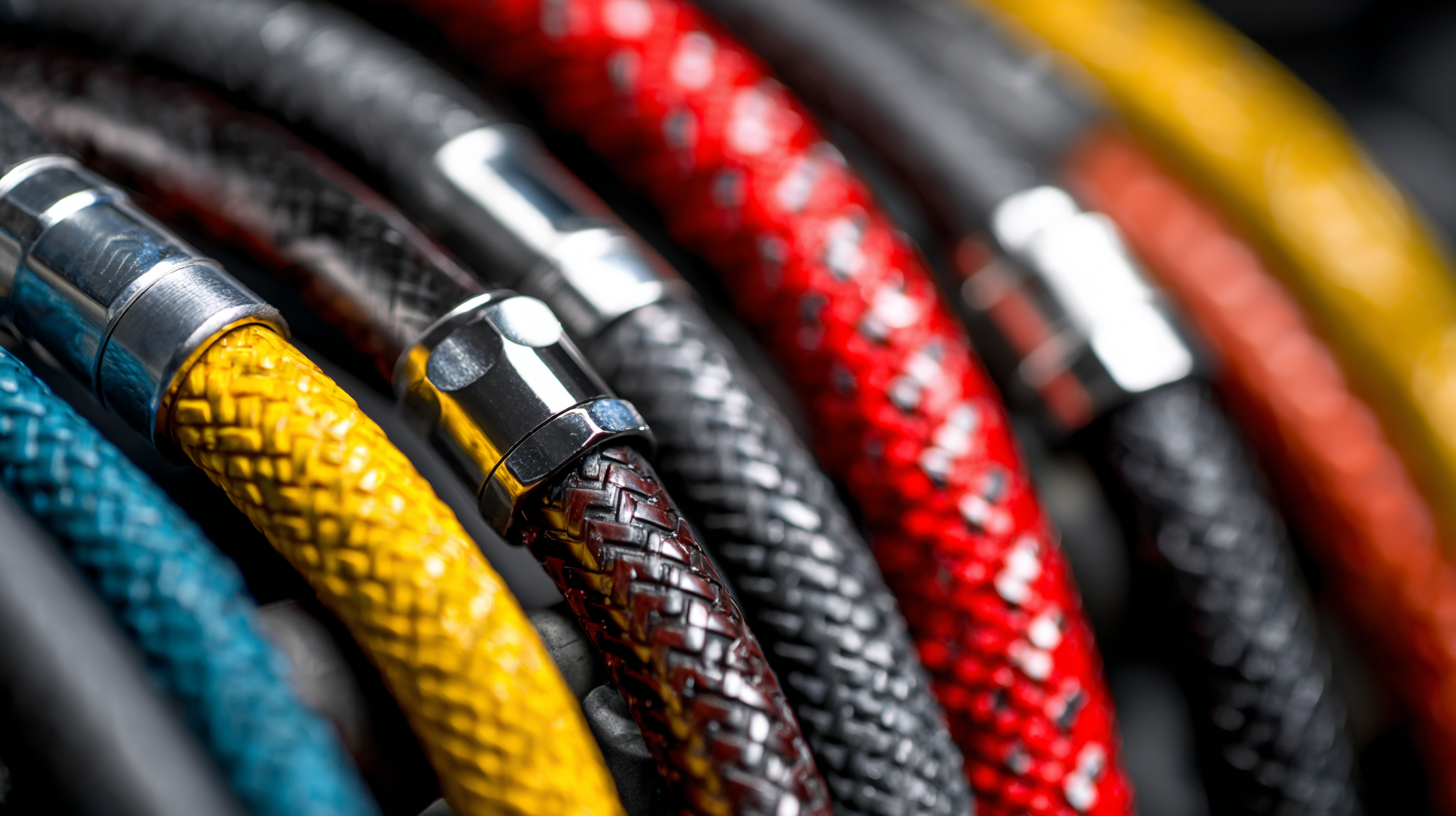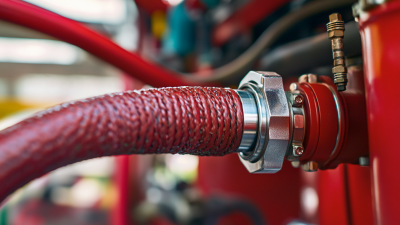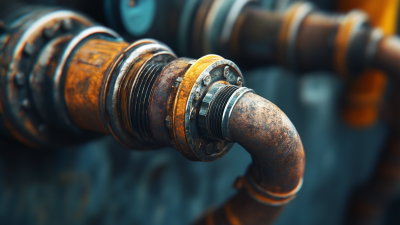- Home Page
- Company Profile
-
Our Products
- Hydraulic Pumps
- Hydraulic Solenoid Valves
- Conventional Valves
- Proportional Valves
- Safety Valves
- Mobile Control Valves
- Hydraulic Motor
- Cylinders and Servo Cylinders
- Hydraulic Filters
- Hoses and Fittings
- Gates Hydraulic Hose
- MP Filters Filters
- Dowty Gear Pumps
- Polyhydron Valves
- Manifold Blocks
- Walvoil
- Spica
- Hand Pumps
- ATOS Hydraulic Components
- Blog

Top 5 High Pressure Hydraulic Hoses: Essential Choices for Optimal Fluid Power Performance
In the ever-evolving landscape of fluid power systems, the significance of selecting the right High Pressure Hydraulic Hose cannot be overstated. According to a recent market analysis by Grand View Research, the global hydraulic hose market is expected to reach USD 3.1 billion by 2025, driven by increasing demand across various sectors such as construction, agriculture, and manufacturing. This highlights the critical role that hydraulic hoses play in the efficiency and reliability of fluid power machinery, where performance and safety are paramount.

High Pressure Hydraulic Hoses are designed to withstand extreme pressures, enhancing the operational capabilities of hydraulic systems. Reports indicate that the demand for high-pressure solutions has surged, with industries aiming for greater productivity and reliability in their equipment. In fact, a study from MarketsandMarkets forecasts a compound annual growth rate (CAGR) of 5.3% in the hydraulic hose market from 2020 to 2025, emphasizing the necessity for premium grade hoses that meet the rigorous demands of high-pressure applications.
As we delve into the top 5 high pressure hydraulic hoses of 2025, it is essential to consider the innovative materials and technologies reshaping the market. These selections not only enhance performance but also ensure compliance with industry standards, safety regulations, and longevity in demanding environments. Understanding these key offerings is crucial for professionals looking to optimize their fluid power performance and ensure the integrity of their hydraulic systems.
Top Factors to Consider When Selecting High Pressure Hydraulic Hoses
When selecting high-pressure hydraulic hoses, it is crucial to consider several key factors that will ensure optimal fluid power performance. First and foremost, the hose's pressure rating is essential. This specification should exceed the maximum pressure of the hydraulic system to prevent catastrophic failures. Additionally, the hose material plays a significant role; options such as rubber, thermoplastic, or metal can greatly impact the flexibility, durability, and temperature tolerance of the hose.
 Another important factor is the compatibility of the hose with various fluids. Different hydraulic systems use specific types of fluids, and the hose material must be resistant to chemical degradation. Furthermore, the hose size and diameter should be compatible with the fittings and the system’s flow requirements to maintain efficiency. It's also beneficial to employ leak-free hydraulic fittings, as they mitigate the risk of vibration failures in high-pressure environments. By carefully considering these elements, operators can select the right hydraulic hose that will enhance safety and improve the overall effectiveness of their machinery.
Another important factor is the compatibility of the hose with various fluids. Different hydraulic systems use specific types of fluids, and the hose material must be resistant to chemical degradation. Furthermore, the hose size and diameter should be compatible with the fittings and the system’s flow requirements to maintain efficiency. It's also beneficial to employ leak-free hydraulic fittings, as they mitigate the risk of vibration failures in high-pressure environments. By carefully considering these elements, operators can select the right hydraulic hose that will enhance safety and improve the overall effectiveness of their machinery.
Types of Materials Used in High Pressure Hydraulic Hoses: Pros and Cons
When selecting high pressure hydraulic hoses, understanding the materials used can greatly influence performance and reliability. Common materials include rubber, thermoplastic, and metal.
Rubber hoses, often reinforced with synthetic fibers, provide flexibility and resilience in extreme temperatures, making them ideal for most hydraulic applications. However, their susceptibility to ozone and UV damage can affect longevity. A study in the Journal of Hydraulic Engineering highlights that while rubber hoses can handle pressures up to 6,000 psi, their lifespan can diminish significantly if exposed to harsh environmental conditions.
Thermoplastic hoses, on the other hand, are gaining popularity due to their lightweight construction and resistance to abrasion. They can operate under high pressures, sometimes exceeding 10,000 psi, and are often used in applications requiring frequent movement. However, they can be more expensive than rubber options, and their rigidity may limit flexibility in certain applications. According to a report by the Hose Manufacturers Association, the thermoplastic hose market is expected to grow by 5% annually, driven by demand in high-pressure environments.
Tip: Always consider the specific conditions your hydraulic system will face. For outdoor use, selecting hoses resistant to UV and environmental factors can prevent premature failure.
In choosing metal hoses, they provide exceptional durability and are crucial for extreme temperature and pressure applications. Although typically more costly and heavier than rubber or thermoplastic options, they can handle even more demanding scenarios, such as those found in aerospace or heavy machinery sectors. According to industry insights, metal hoses often have a lower failure rate in high-demand applications.
Tip: Regular inspections and maintenance are vital, regardless of the material, to ensure optimal performance and prevent costly downtime.
Key Performance Metrics for High Pressure Hydraulic Hoses Explained
When evaluating high pressure hydraulic hoses, it's essential to understand key performance metrics that directly impact their efficiency and durability. These metrics include pressure rating, temperature range, and flexibility. Pressure ratings indicate the maximum amount of pressure the hose can handle before failing, while temperature ranges define the operating environment in which the hose can sustain its structural integrity. Flexibility affects the ease of installation and maneuverability of the hose within various systems.
Tips: Always check the specifications of the hose against the requirements of your specific application to ensure compatibility. An appropriate pressure rating should exceed the maximum pressure expected in your system by at least 20% for safety. Additionally, consider the working environment: a hose that can withstand high temperatures will be crucial in applications where heat is a factor.
Another important metric to consider is abrasion resistance. Hoses often encounter rough surfaces, and resistant materials can prolong the lifespan of a hydraulic hose significantly. It's advisable to choose hoses with protective covers or reinforced layers, especially in high-wear applications. Regular inspection and maintenance also play a crucial role in enhancing the performance and longevity of hydraulic hoses, ensuring they meet the demands of fluid power operations.
Top 5 High Pressure Hydraulic Hoses: Essential Choices for Optimal Fluid Power Performance
| Hose Type | Max Pressure (psi) | Inner Diameter (inches) | Outer Diameter (inches) | Temperature Range (°F) | Weight (lbs/ft) |
|---|---|---|---|---|---|
| Rubber Hydraulic Hose | 4000 | 0.75 | 1.10 | -40 to 212 | 0.45 |
| Thermoplastic Hydraulic Hose | 5000 | 0.50 | 0.92 | -40 to 190 | 0.35 |
| Wire Braided Hydraulic Hose | 6000 | 1.00 | 1.40 | -40 to 250 | 0.60 |
| Spiral Wire Hydraulic Hose | 8000 | 1.25 | 1.70 | -40 to 300 | 0.80 |
| Composite Hydraulic Hose | 4000 | 0.75 | 1.25 | 0.50 |
Maintenance Tips for Extending the Life of Hydraulic Hoses
Maintaining hydraulic hoses is crucial for ensuring optimal performance and extending their lifespan. According to the International Hydraulic Industry Standards (IHIS), proper maintenance can increase hose life by as much as 50%. Regularly inspecting hoses for signs of wear, such as abrasions or bulges, allows for early detection of potential failures. Additionally, cleaning hoses to remove dirt and contaminants can prevent premature degradation caused by external factors, which studies show account for up to 30% of hose failures in high-pressure applications.

Temperature management is another vital maintenance aspect. Research from the Fluid Power Journal indicates that operating hydraulic hoses at temperatures exceeding their rated limits can reduce their lifespan significantly, up to 60%. It is essential to monitor fluid temperatures and ensure they remain within manufacturers' specifications. Furthermore, routine checks of coupling integrity and tightness can prevent leaks, as failed couplings are responsible for 25% of hydraulic system inefficiencies. By adhering to these maintenance tips, operators can not only enhance the performance of their hydraulic systems but also contribute to lower operational costs and increased safety.
Future Trends in Hydraulic Hose Technology and Performance Enhancements
The hydraulic hose industry is undergoing significant advancements as manufacturers strive to enhance performance and durability. With the increasing demand for efficient fluid power systems, future trends are leaning towards the development of hoses that can withstand higher pressures and temperatures. Innovations in materials, such as synthetic rubbers and advanced composites, are enabling the production of hoses that not only meet but exceed the current operational standards. These trends point towards a more robust structure, incorporating multi-layer designs that improve resistance to abrasion, crushing, and chemical exposure.
Moreover, the integration of smart technologies into hydraulic hoses is gaining traction. Sensors embedded within the hoses can monitor real-time pressure and temperature, providing critical data that enables predictive maintenance and minimizes downtime. This move towards smart hydraulic systems aligns with the broader trend of automation and increased efficiency in various industries. As these technologies continue to evolve, we can expect a transformative impact on fluid power performance, setting new benchmarks for safety and reliability in hydraulic applications.
Top 5 High Pressure Hydraulic Hoses Performance Comparison
Related Posts
-

How to Choose the Right Hydraulic Hoses for Your Industrial Applications
-

Exploring the Best High Pressure Hydraulic Hose Alternatives for Diverse Industrial Applications
-

Exploring Innovative Alternatives for Optimal Industrial Hose Fittings
-

7 Innovative Uses for Hydraulic Hoses in Industrial Applications
-

What is the Importance of Industrial Hose Fittings in Global Supply Chains
-

Exploring Unique Features and Applications of Various Pressure Hoses for Global Buyers
Developed and Managed byInfocom Network Private Limited.

 Send Inquiry
Send Inquiry
